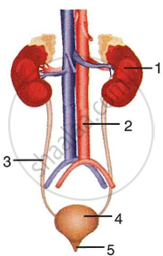Advertisements
Advertisements
Question
Write one specific function each of the following organs in relation with excretion in human beings:
- Renal Artery
- Urethra
- Glomerulus
- Tubular part of nephron
Solution
- Renal Artery: It provides oxygenated blood to the kidney muscles.
- Urethra: Urine can pass through this tube and leave the body.
- Glomerulus: It serves as a blood filter by removing the nitrogenous wastes from the blood.
- Tubular part of nephron: The necessary salts and water content from the filtered blood are absorbed and reabsorbed with its assistance. As a result, they preserve the blood's osmolarity.
APPEARS IN
RELATED QUESTIONS
Kidneys eliminate the waste materials in the liquid form called ______.
Tick the most appropriate answer.
Plants maintain the concentration of sap inside their body with
Fill in the blank.
.................. carries urine from the kidney to the urinary bladder.
One of the following sets of body parts or substances or processed, pick out the one item which overall includes the remaining foir.
Glomerular filtrate, bowman’s capsule, ultrafiltration, glomerulus, blood plasma.
Given alongside is the figure of certain organs and associated parts in the human body. Study the same and answer the questions that follow:
 |
- Name all the organ systems shown completely or even 3 partially.
- Name the parts numbered 1 to 5.
- Name the structural and functional unit of the part marked '1'.
- Name the two main organic constituents of the fluid that flows down the part labelled '3'.
- Napie the two major steps involved in the formation of the fluid that passes down the part labelled '3'.
Choose the Odd One Out:
Arrange the excretory system in the correct sequence.
(Urinary bladder, Ureter, Kidney, Urethra).
Differentiate cortical from medullary nephrons.
Match the terms given in Column I with their physiological processes given in Column II and choose the correct answer
| Column I | Column II |
| A. Proximal convoluted tubule | i. Formation of concentrated urine |
| B. Distal convoluted tubule | ii. Filtration of blood |
| C. Henle's loop | iii. Reabsorption of 70 - 80% of electrolytes |
| D. Counter-current mechanism | iv. Ionic balance |
| E. Renal corpuscle | v. Maintenance of concentration gradient in medulla |
Match Column I with Column II.
| Column I | Column II |
| A. PCT | (i) Concentrated urine formation |
| B. DCT | (ii) Filtration of blood |
| C. Loop of Henle | (iii) Reabsorption of 70-80% of the electrolyte |
| D. Counter current mechanism | (iv) Ionic balance |
| E. Renal corpuscle | (v) Maintenance of concentration gradient in medulla |
Select the correct option from the codes given below.
